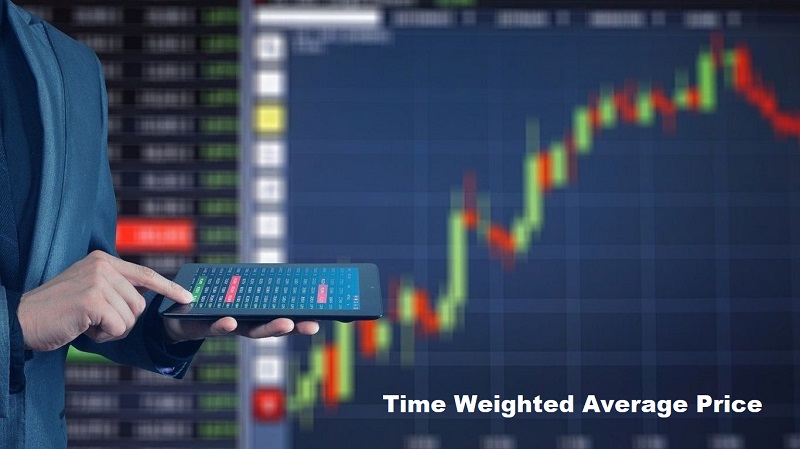Time Weighted Average Price is probably something you’ve heard of (TWAP). These cumulative indicators provide a Time-weighted average price from a specific starting point.
Large institutional traders frequently place high-volume orders with the potential to cause significant market volatility and disruption. As a result, these traders attempt to use trading strategies that reduce the impact of their orders. They also frequently employ strategies to conceal their trading intentions from their main competitors, other large-scale traders.
Large institutions commonly use the time-weighted average price (TWAP) and trading strategies based on TWAP for these purposes.
Page Contents
What is TWAP?
TWAP is a well-known trading algorithm that is based on the weighted average price and is defined by the time criterion. TWAP is used to calculate the cost of executing large trade orders. Because the TWAP price is the most advantageous value, the trader can divide a large order into a few small orders valued at the TWAP price.
This is done primarily to prevent a large order from suddenly increasing the value of a specific financial asset in the financial market. Let us now look at a TWAP example.
Example of TWAP
Assume someone wants to devise a strategy for purchasing 10,000 shares of an asset. During the strategy-making process, one can choose between two possible strategies. For example, a trader can place orders to buy 500 shares every 15 minutes for 5 hours.
The second example is that the trader can employ a strategy in which an order to purchase 1,000 shares is issued every 15 minutes for 2.5 hours.
However, when a strategy is active in the financial market, it is easier to track the trading patterns of other traders and make educated guesses about the next strategic plan unless and until its orders are altered by varying the parameters. This modification also implies that the size of the orders can be randomized or the time between every order can be temporarily halted.
Let us now investigate how the TWAP value can be calculated over a longer period.
TWAP calculation
TWAP is calculated by averaging the entire day’s price bar, which includes the open, high, low, and close prices for the day. Then, based on the time decided to execute an order, the average price for each day is used to calculate the average of the prices for the entire duration. This is referred to as the TWAP.
TWAP is the best execution strategy for spreading out trades over a specific period and minimizing the effects of trade on the market.
The TWAP, like any other trade, accomplishes when all of the conditions are met, and the price is calculated from the time the order is placed until the market closes.
TWAP calculation formula
The following is how TWAP is calculated:
Each day’s average price = (Open + High + Low + Close)/4
Average of 28 days = (Average of first day’s price + Average of second day’s price +……..+ Average of twenty-eighth day’s price)/28
TWAP strategy application in trading
TWAP is typically used to distribute large orders throughout the trading day. For example, suppose you want to purchase 100,000 Tesla shares. Placing a large order would almost certainly affect the market, causing the price to rise.
To prevent this, you can specify a time frame for purchasing the shares. The TWAP criterion will assist you in dividing the large order into small transactions and executing them over the specified period.
Moreover, traders are recommended to use the TWAP on securities that do not have a volume profile obtainable or over a short period, as there is still the chance of trading during a period of low cash flow, in which case divided orders will still weigh on the sector.
What is the significance of TWAP?
TWAP is important for a variety of reasons. The indicator gives more weight to recent price changes while still taking into account past information. When combined with other indicators, it is an excellent trading tool for determining a trend.
Here are some of the advantages of TWAP
- TWAP is an excellent solution for executing orders in smaller parts over time rather than a single large order in one go. For instance, suppose your trading algorithm generates a buy signal and you want to purchase 10,000 shares of stock. You can reduce the market impact by slicing this order into small orders, say 250 or 500 per hour/minute.
- It enables traders to distribute their orders throughout the day without disclosing their roles to rival traders or disrupting the market rate.
- It is ideal for those who engage in high-frequency trading or other quantitative trading methods such as algorithmic trading.
- It reduces implications costs and is a simple indicator to use in your research.
- It has no effect on market price with the execution of the entire large order.
Conclusion
The TWAP trading strategy and indicator is a useful tool for traders to use when entering and exiting trades. Traders can use this simple trading strategy to make comparisons of stock price points over time.
It is closely related to the volume-weighted average price, which shows the average price at which safety has traded over time, weighted by the volume of trades. On their trading charts, numerous traders use this indicator in conjunction with candlesticks.
While managing this indicator will take time, it is well worth the effort has given how important it is for day traders to have a clear picture and the best circumstances to form an opinion.
And the TWAP does just that – it can improve your trading strategy and make decision-making easier.











